A few weeks ago, Auckland Council took another step in the long-running stadium saga, narrowing its shortlist down to two options for which they will now seek feasibility studies.
The recommendation to move forward with a feasibility study was carried twenty to one by the council’s Governing Body for the Eden Park 2.1 (Eden Park Trust) and Te Tōangaroa/Quay Park (Te Tōangaroa Consortium) options to be assessed against the status quo. Both bidders have been invited to complete their feasibility studies within a 6 month timeframe, at their own expense.
This week, we’ve passed a milestone and we’re now going to move forward to a feasibility study to look more closely at the future of a city stadium for Auckland.
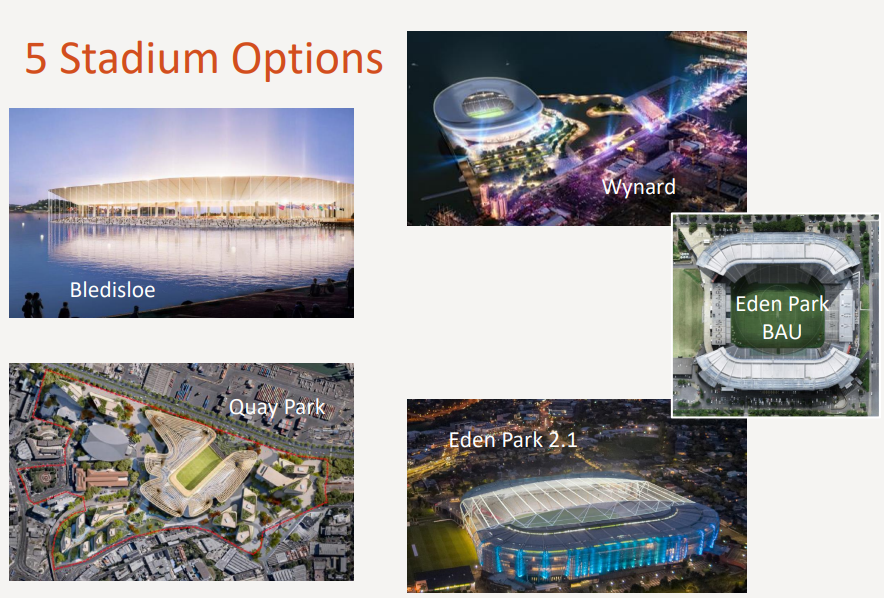
Putting aside the question of whether we should have a new/upgraded stadium; based on the limited detail that had been provided about the four options under consideration, these two did seem like the two strongest options. Among other reasons, the Bledisloe ‘sunken’ stadium never seemed all that practical, while the Wynyard one would have taken land intended to be a fantastic new public park while also being too far away from public transport.
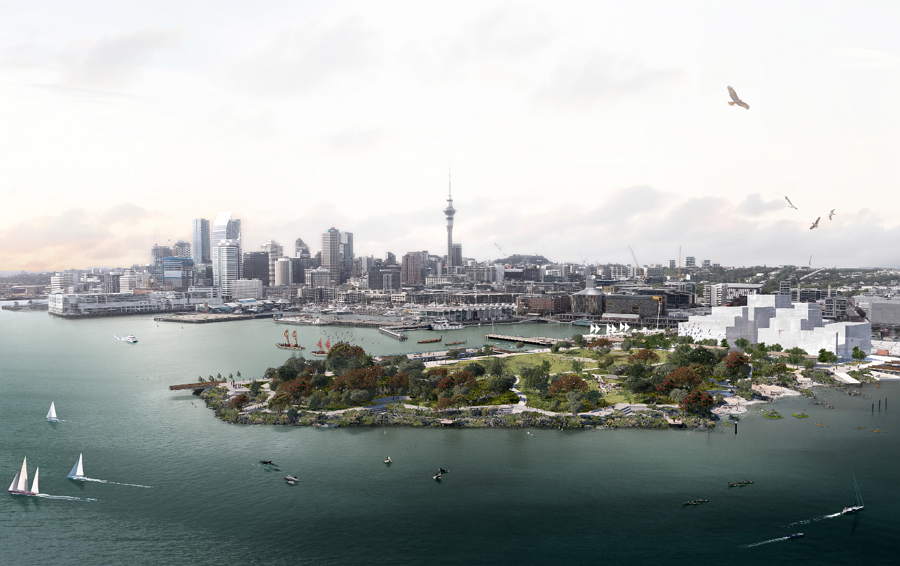
One thing I’ve been thinking about with the two selected options is the transport aspects, especially as there’s not been a lot of information about this. About the most we have is from an independent evaluation report for the council, which notes:
Transport Connectivity
- With advice from Auckland Transport[,] Eden Park accessibility was assessed as adequate (especially post CRL), but all 3 CBD locations rated higher being close to the centre of the transport network.
- Of the 3 downtown locations Bledisloe & Quay Park were considered best equal being closer to Britomart and road connections. Wynard was not rated as highly due to greater distance from Britomart, peninsular location and more constrained roading links.
It seems, understandably, that all proposals wanted to solely rely on our existing transport infrastructure to support their bids, rather than having to also invest in upgrading transport connections as well as building a stadium. But I do wonder whether the existing transport provision would be enough. My sense is not, so I’ve taken a look at the transport challenges and opportunities of the two remaining candidates.
Eden Park – the transport challenges and opportunities
I’m not sure I agree with Auckland Transport’s assessment that Eden Park accessibility is ‘adequate’, even once the CRL opens. While serivices will be a bit better once the CRL is up and running, our rail network is still very ‘skinny’. This gives it very little resilience, and relies heavily on everything going exactly right with very little room for error. This often doesn’t happen, as we saw recently with the Pink concerts.
Furthermore, especially when there are large crowds involved, it can be difficult to even get to (or through) Kingsland Station if you’re not heading towards the city. And of course if you’re one of the majority of Aucklanders who don’t live on the rail network, getting to Eden Park via public transport is even harder.
As I noted after those Pink concerts, a key issue is that our ‘skinny’ rail network means there is little opportunity to store trains close to the station – which means AT needs to run any additional event trains all the way from Swanson. I made the suggestion that if large events are to stay at Eden Park, perhaps AT could look at redeveloping the land around Morningside Station to provide storage for trains for events (and maybe also for some of the additional peak services AT plans to run post CRL). This could be combined with grade separation of the Morningside Drive level crossing. Surely something like this should be included as part of any stadium proposal.
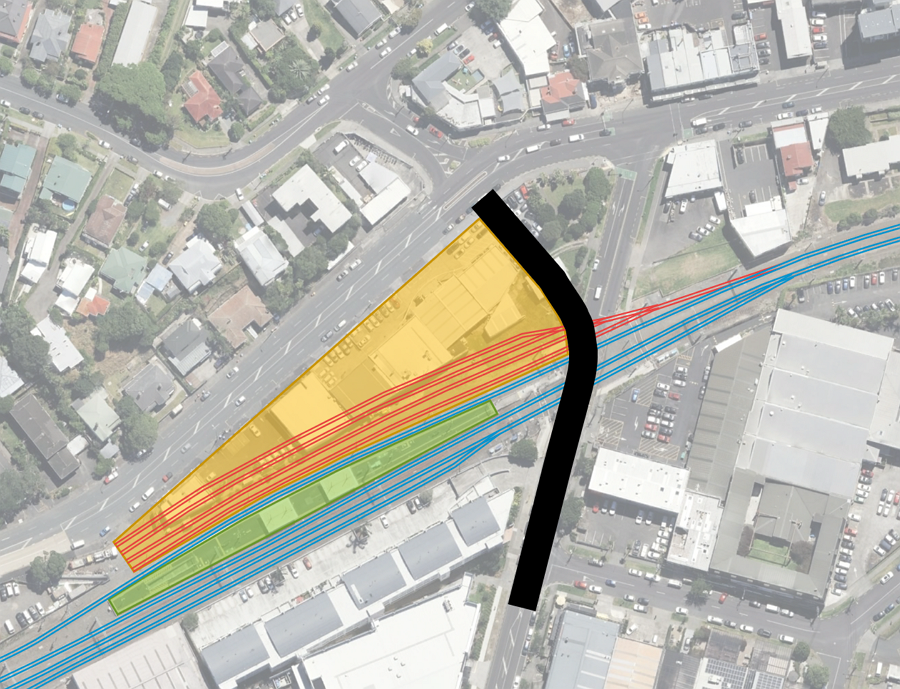
One small transport aspect that was included in the proposal released last year – known as Eden Park 2.0 – was a new pedestrian bridge from Kingsland Station to the stadium. It’s hard to see just what that would achieve; given the number of people at large events, closing Sandringham Rd would likely still be required anyway.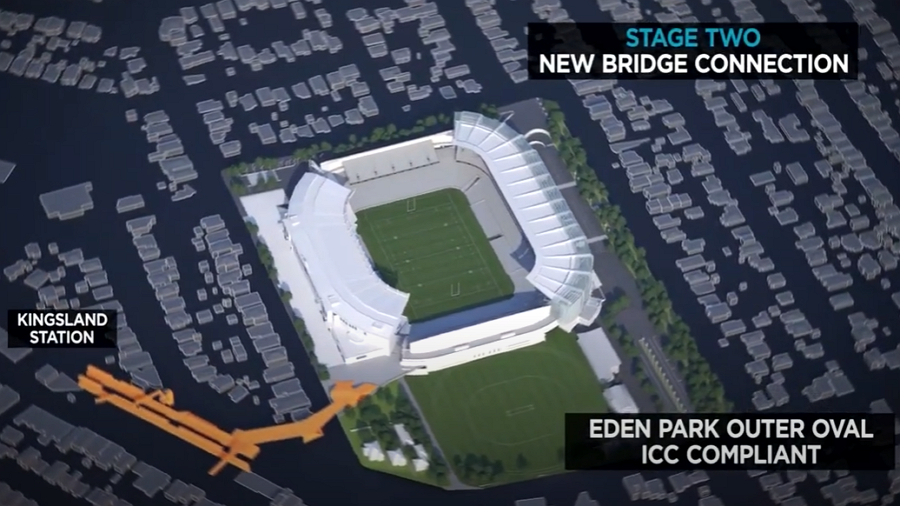
That proposed pedestrian overbridge doesn’t appear to be in the render released for the current 2.1 proposal.
However, it did get me wondering if we could ever have a proper event station at Kingsland, and by that I mean a station with additional tracks and platforms to enable more services to or through the station. Even with large crowds eager to get on, it can take a while to fully load a train. Additional platforms would give more flexibility and allow for higher frequencies, providing more overall capacity for large events.
I’ve always assumed such a station wouldn’t be possible due to the narrowness of the rail corridor and how tightly it runs alongside neighbouring Sandringham Rd. It looks like there’s simply no room for anything else. However, thinking about it some more, it would surely be possible to do if you were prepared to buy a few properties, thus enabling Sandringham Rd to be realigned to give more space for a larger event station.
You could even connect the suggested pedestrian bridge to an upgrade of the existing one, to help provide access to those platforms. And while we’re at it, how about at least easing up on some of the heritage provisions in the area, to enable at least the land immediately next to the station to be redeveloped into higher density housing.
All of this wouldn’t come cheap, but it should surely be part of the equation if Eden Park is to become the long-term national stadium. Especially if we’re looking to maximise the potential of not just the stadium itself, and the current transport investments, but also this neighbourhood as a place for more people to live.
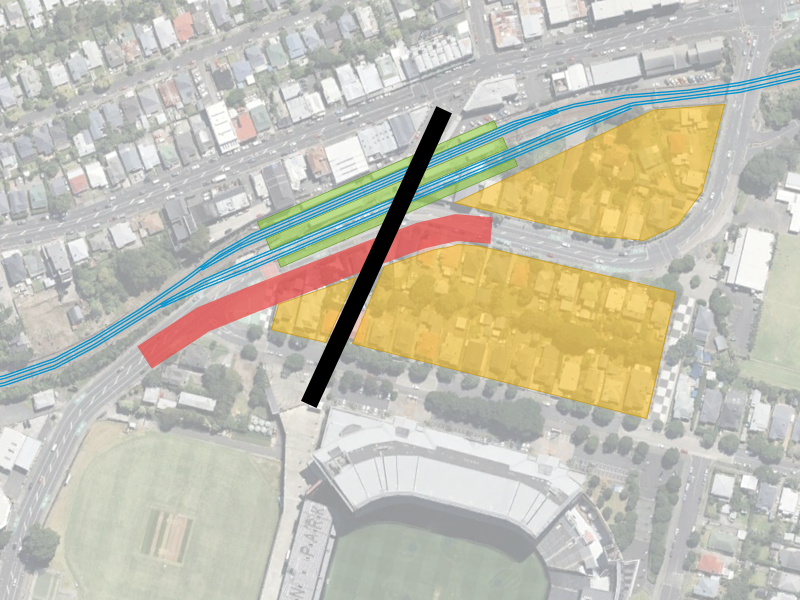
Te Tōangaroa (Quay Park) – the transport challenges and opportunities
One of the major benefits of a central city based option like Te Tōangaroa is that at the end of an event a lot of people are likely to linger in the city, visiting bars and restaurants and so on. Besides the economic benefits, this has the advantage of helping to spread out the demand for travel, making it easier to manage the flows of people heading homewards.
But the Quay Park proposal comes with other issues, notably that it will likely need to sit over the existing rail lines. However, this might provide some opportunities too.
The need to build a podium over the top of the existing rail lines is likely to not only add quite a bit of cost to the project, but would also be quite disruptive to rail services during construction. One way to minimise that would be realign and trench that section of the Eastern Line. It does seem they want to take some land from the port to shift Quay St north, which would likely provide the needed space.
This would also provide a golden opportunity to grade-separate the Quay Park junction. This would have large benefits for the entire rail network by helping to improve reliability. This flat junction already imposes a significant constraint on all rail services in Auckland, as trains travelling in opposite directions entering and exiting Britomart need to cross paths – and when that happens, even small delays on a single service can quickly cascade across the network. That will only get worse as service frequencies increase post CRL. The need to grade-separate this junction has been identified as a likely future requirement in Auckland Transport and Kiwirail’s 30-year rail business case – so hopefully the designers of this stadium have included it in their plans.
I’m also not all that sure Britomart has much more passenger capacity than Kingsland. Like Kingsland, it will only have two tracks/platforms for through services, and while there will still be a couple of additional platforms which I’m sure would be used for special events, it won’t provide all that much extra capacity.
Given the proposal also includes a range of other developments in the area, it would also make sense for the plans to include a new station on the Eastern Line, likely near the eastern end of the development – roughly where The Strand is today. This would also support the catchment in northern Parnell and any future redevelopment of the port.
There is plenty of space in the rail corridor for a station here, likely enough for at least six platforms. As described in this post from 2016, that would enable two platforms for regular everyday services, two for special events as I’ve suggested at Kingsland, and a couple more for intercity services like Te Huia.
Aside from rail, AT’s current City Centre Bus Plan is looking to extend the North Shore buses that currently terminate in Lower Albert St towards a new terminus somewhere on the eastern side of the city. This would likely be close to, or perhaps could be integrated into this development around on Quay Park.
One last thought: if the Te Tōangaroa location were to go ahead, it would also surely help the case for reopening the Albert Park Tunnels, which run from Beach Rd through to Victoria St. This would be ideal for providing a pedestrian and bike/scooter access from the stadium and related development, right though to the middle of the city centre – leading directly to the new Waihoritiu station and the Victoria Street linear park and protected cycleways. (While also providing vertical access to the university area along the way.)
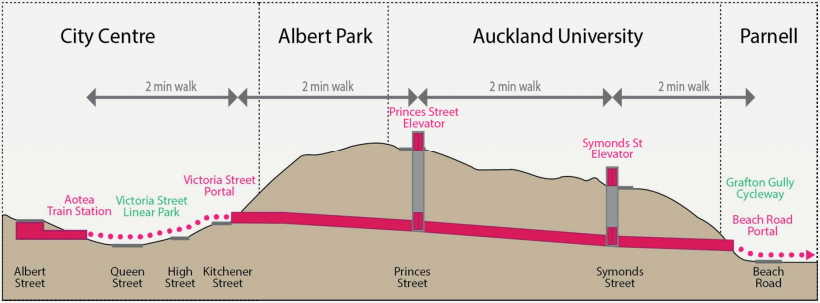
In conclusion
To me, there’s quite a bit of transport infrastructure these projects should be looking to integrate into the vision – either directly by constructing it as part of their project, or at least contributing towards its simultaneous development. Hopefully this is something Council and its transport partners are on top of. And hopefully we’ll hear more detail as this process continues. After all, if you build it (a stadium), they will come – so you’d better be comprehensively planning how to get everyone there and back again.
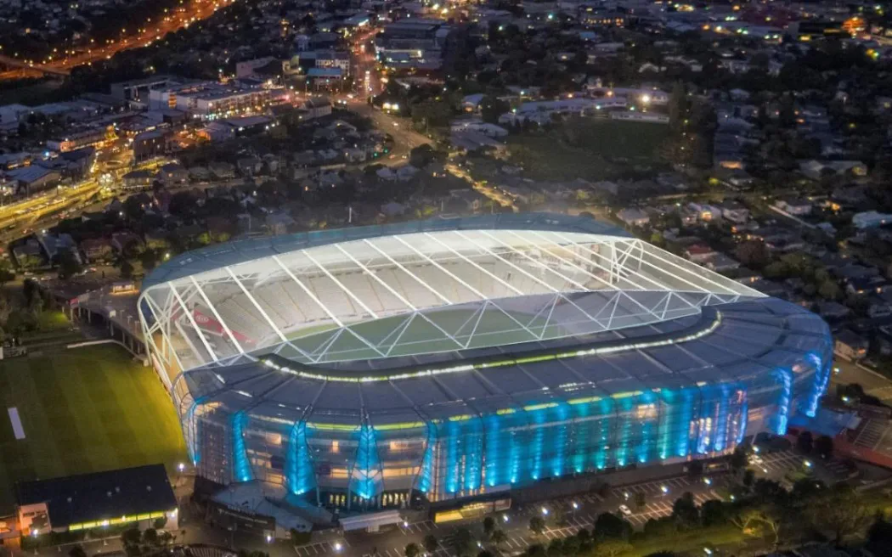
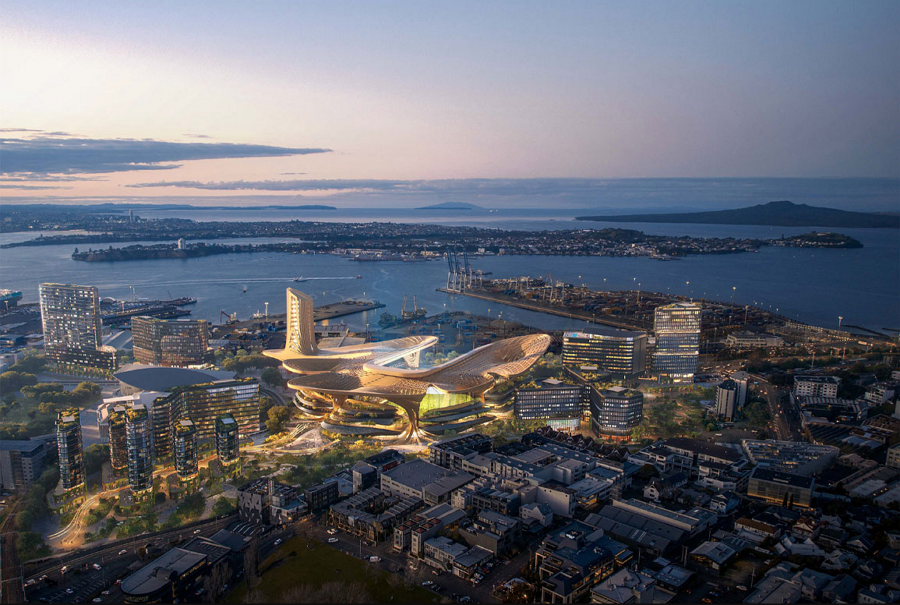
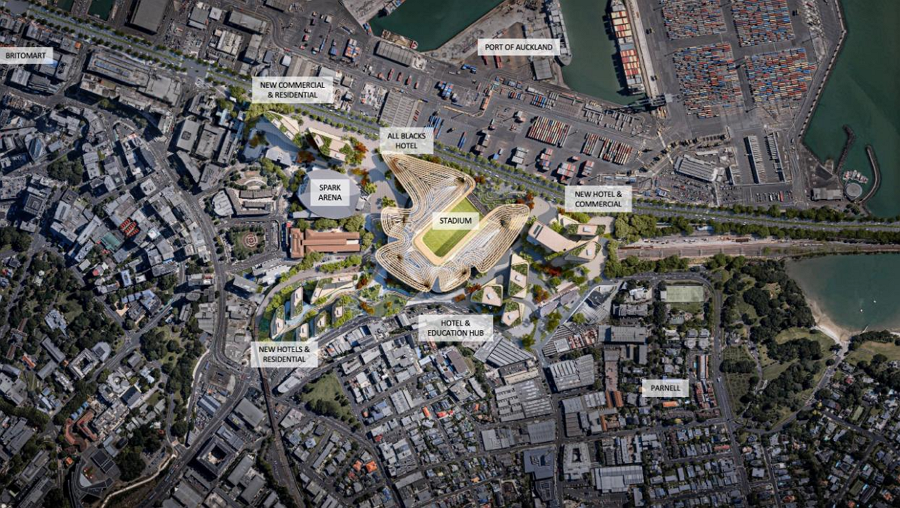
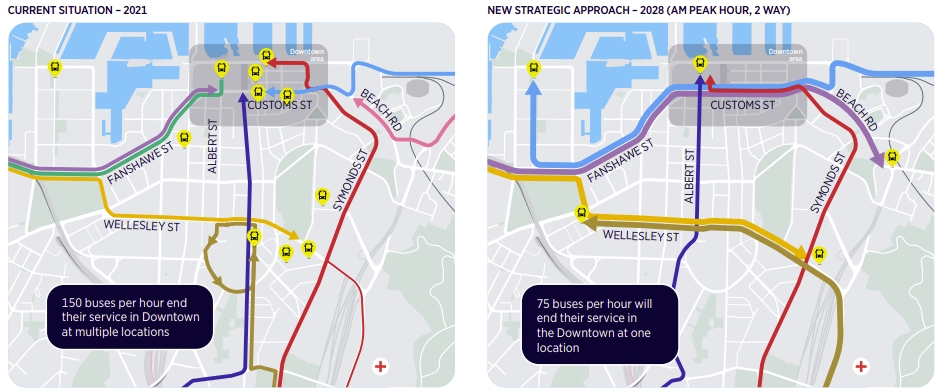

 Processing...
Processing...
The Council doesn’t have the money for a stadium so why are they wasting other people’s cash asking for feasibility studies? The best answer is for the Council to track down the people pushing this idea and fire them.
Have to agree with miffy, when AC have been cutting so broadly and deeply to the point rubbish bins are being removed it seems absurd and bad optics to be looking at stadiums
Great point by Phil surely council can’t be serious about wasting money on this?
That’s what councils are best at doing though. 😀
It’s not their money, so they have no qualms with spending it, apparently.
+1
The proposals are for the stadiums to be built and operated using private funds.
“Submitters were asked to present options for a national stadium that could be delivered at little to no cost to ratepayers”
I’m skeptical of that, such a large and costly project will never be built with out significant concessions from the council, it will just be a matter of what forms those concessions take.
Economic research studies by lobbyists and stadium promoters, try to estimate the local annual economic impact. Such studies often overstate the economic impact of a facility because they confuse gross and net economic effects. Most spending inside a stadium is a substitute for other local recreational spending, such as movies and restaurants. Similarly, most tax collections inside a stadium are substitutes: as other entertainment businesses decline, tax collections from them fall.
These studies also fail to take into account differences between sports and other industries in income distribution. Most sports revenue goes to a relatively few players, managers, coaches, and executives who earn extremely high salaries—all well above the earnings of people who work in the industries that are substitutes for sports. Most stadium employees work part time at very low wages and earn a small fraction of team revenues. Thus, substituting spending on sports for other recreational spending concentrates income, reduces the total number of jobs, and replaces full-time jobs with low-wage, part-time jobs.
Nice things require ratepayer subsidies. Think swimming pools, libraries, trains and buses.
AC puts $35m a year into the Museum coffers, and IMHO it’s worth it. Why not some contribution to a world class sportd and entertianment facility to bring events to ratepayers? Or are we only allowed nice things as long as it’s not for (amongst others) sport?
Until the inevitable crisis when Councillors will be told they have no choice but to underwrite the whole thing. Just like happened when they built North Harbour Stadium. Nobody is dumb enough to believe a large stadium will ever make a profit or cover opex let alone provide any return at all on capital. This is just part of the game these people play with ratepayers money. They have built careers out of this bullshit and know all the right emotional buttons to push.
Maybe, but calling for people to be fired for merely investigating whether this is possible is absolutely scummy.
No the scummy part is Council officers who find ways to increase rates every year. they see the inflation rate as the start point and try to increase well above that. Currently the Reserve Bank is creating a recession that will result in people losing their jobs all because inflation is being driven by Council rates and government fee increases. The sooner the people at the Councils responsible for this are fired the better off New Zealand will be.
…and then when things are nearing (design and approval) completion, suddenly things turn around and massive “co-funding” is required. And populist mayors then are wary of being seen as killjoys and commit their cities.
We’ve never seen back all the cash we “lent” Eden Park in the past.
Stadium in practice end up a massive drain on city finances worldwide. You can argue that they have economic benefits for cities as such, and that great stadium events are a boon for people. Sure. But the reality is that Council cash in large amounts always somehow ends up required.
So yeah, maybe not a good look right now.
The problem is half of NZ dont pay rates, but still get to vote.
If you are a fan of the new stadium and only rent, or live with your two Moms, then of course you are in favour of the spend.
You’re so right Elon..I rent and I’m so lucky that my landlords pay the rates at no cost to me, out the kindness of their hearts.
What a terrible take.
Hey Joe,
Your landlord charges you the maximum rent that his property can sustain. He does not sit down and work out if the rates, mortgage costs and other OPEX are calculated in the price.
Proof of concept, did you get a rent increase everytime the rates went up? Do you get a rent adjustment along with the bank lending rates?
This notion that renters pay rates is ridiculous, put forward by renters that want to continue to enjoy their free ride. Sorry if that offends you, but it is the reality amigo.
lmao okay, bootlicker naming themselves after the apartheid billionaire who just got a $56 billion pay packet. talk about getting a free ride.
Here are some facts about taxpayer funding for professional sports stadia: See: https://theweek.com/sports/taxpayer-subsidized-stadiums
Research conducted over decades indicates these investments almost never lead to massive economic gains for host cities. See: https://journalistsresource.org/economics/sports-stadium-public-financing/
Following the glossy presentations from both promoters, we can expect to see a request for taxpayer funding, based upon some pie in the sky statement that the stadium will generate millions of dollars of revenue for Auckland.
Even stadiums ostensibly built with private funds can come with public costs.
For example, the New England Patriots built Gillette Stadium in 2002 without direct public dollars, but the franchise benefitted from at least $70 million in state money for nearby road, sewer and other infrastructure improvements, according to the Boston Globe, which the paper authors cite.
Despite perennial claims from team owners that building new stadiums or revamping existing ones will result in a fiscal and jobs boom for a city or region, research consistently shows that the hundreds of millions of public dollars that are often outlaid are not typically a sound investment.
The findings: Average personal income grew about 1.4% per year over the period studied, regardless of whether there was a sports stadium in the area. The economic effects of sports franchises account for less than 1.5% of local economic activity, measured by personal income, wages and salaries, and wages per job.
The author writes: “The results of this exercise are largely consistent with the findings of Coates and Humphreys and of numerous other studies that have found that the effect of sports franchises and stadium and arena construction on local economies is weak or nonexistent. Indeed, franchises, stadiums, and arenas may be harmful rather than beneficial to the local community.”
“Overall, we find no substantial evidence that entry of a new team or stadium is associated with any net gains related to economic development, other than for minor league team entry in smaller markets and employment effects limited to the period of construction.”
Bus Driver – US analysis isn’t helpful (although I concur with it) because Auckland Council would not contribute anywhere near the subsidy you see in the US and we are not talking about a new stadium to entice a professional sports team to move for claimed economic benefits.
We don’t really know what or hiw much the council would need to contribute but I am guessing it’s something long the lines of what they subsidise the running of EP now.
Based on what the council claim, this isn’t council initiated but a response to the many proposals that have sprung up over the years from different groups. Therefore the purpose of this work is to weed them all out to the one best option. A bit of put up or shut up rather than something being pushed by council.
This also includes that the various proponents being required to pay for the feasibility studies for these stadium proposals themselves, not the council.
100%. If we’re looking for waste, building new stadiums (and having people even looking into it) is a lot more wasteful than having some rubbish bins in some parks.
If we’ve got to do something, grade separate Morningside, use the tracks in between Kingsland/Morningside to stack trains during events. One big expensive bridge (that’ll need to happen anyway), then job done. I’d love to say the bridge will be built at great value for money, but we all know that’s fairly unlikely given our contractors greed/ATs loose stewardship of ratepayer cash.
Council has made abundantly clear on several occasions that they will not be contributing any tax payer funding
And some idiots actually believe that. Where in NZ has a stadium ever been built without a huge bill to taxpayers and ratepayers?
Eden Park is already costing ratepayers millions. It’s a just a shift to a better looking white elephant.
The P!nk concert was a fuck up because KiwiRail has borrowed parts from a crossover beside Kingsland Station for another part of the network to enable the RNR. Typically, it works completely fine as AT can stack trains in between Morningside and Kingsland for City bound from Kingsland and West bound from Morningside (though this does require closing Morningside Drive level crossing). Plus they convert the carpark to a pop-up bus terminal. Remember at the 2011 World Cup Eden Park was 60k seated and worked okay. CRL will boost access further.
Presumably to do that you also have to cancel timetabled trains to allow trains to be stacked on the main line? Doesn’t seem like that flash of a plan
personally I’d rather listen to the EMU wheel screech around the bend in Quay Park than Pinks screech – strangled cat sounds and all that hahaha.
But yes it shows that a lot of work is needed to improve access to Eden Park. I like the idea of widening Morning side to allow train stacking and a proper pedestrian overpass/promenade to Eden Park (a bit like the outside of the Cake Tin in Wellington).
Really hope that Wynyard park gets built looking like that, with no further car parks in Wynyard. Lots of PT connections. Looks fantastic.
Now we just need the bridge fixed so we can ccess it…
We have a central stadium, it is popularly known as Eden Park, two train stations serve it very well and during the Rugby World Cup a walk-able path from Downtown was created.
Spark Arena is an excellent medium size venue, for both sport and music.
We do not need another large venue. We need more small venues to support our local artists.
And we need public transport to arrive at these places. That means LIGHT RAIL.
The council is wasting time with this stadium debate. Wasting ratepayers time.
Debates should be taking place on how to maximise land for apartment construction, how to connect the less connected parts of our greater city with Light Rail, to reduce the unfair working conditions of bus drivers who are constantly exposed to sickness, aggressive passengers, and overwork.
If we believe in a connected city, we need to connect it through public transport.
If we treat ourselves as a big town, we will continue to be an over-populated version of Wairoa on the East Coast.
Cities are defined by their public transport and their shiny towers of apartments. That is what defines a city, as well as a few more people than we currently have here.
Build apartments and the people will come. Build better public transport and the people will come.
Then we can call ourselves the mighty Taamaki Makaurau, Auckland!!!
bah humbug
Better go with Eden park cause how many rail buses would it take to implement all the changes to the railway that Matt.L has in store for the Quay Park option.
It’s a very valid point.
I just assumed that the Quay Park option would include a dedicated rail stop.
But I guess they built the arena without a rail stop and that is literally right next to the rail line.
The render of the park at the end of Wynyard does look awesome.
You could start with an events stop at The Strand but yes, if it’s going to ultimately be truly mixed use, it will need it’s own stop. Have one at The Strand and it can be accesses by both the Eastern and Southern lines (albeit with a bit of a walk)
I just assumed that the Quay Park option would include a dedicated rail stop.
But I guess they built the arena without a rail stop and that is literally right next to the rail line.
The render of the park at the end of Wynyard does look awesome. Especially the Haast’s eagles flying around
There’s no sensible reason for a new or upgraded stadium to be downtown or city fringe. Putting a stadium somewhere it’s hard for the majority of Aucklanders to get to without causing congestion problems then doing otherwise unnecessary upgrades to solve the just created congestion problem seems somewhat counterproductive.
Yes, just put it in the Southern/Western motorway because those are never congested.
From a transport perspective, Quay Park does make sense, if only very few carparks are provided. Nobody who does not rely on walking aids or a wheelchair should drive there to attend an event.
“Putting a stadium somewhere it’s hard for the majority of Aucklanders to get to…”
It would have direct access from all 4 rail lines, east, West and south. Direct access by buses from the north expressway, the Tamaki route to the east, and inner link which stops south of the site. Ferry terminal a short walk/bus ride away. I can’t think of a better place to access a stadium.
And then there are the thousands of carparks in the near vicinity.
If there is congestion when driving to an event, you are choosing to contribute to that.
This is a test – I typed a post but it was somehow not published?
A note: when comments that breach our user guidelines have been removed, any replies to those comments may also no longer be viewable.
We appreciate all our readers helping keep the discussion civil, constructive and on track. Our user guidelines are here: https://www.greaterauckland.org.nz/user-guidelines/
Eden Park has required in the past ,an expensive to implement traffic plan,that restricts vehicle movements in the area. It is one of the reasons the Blues are reticent, to play their games there,costs ,out weigh income. Other users of the park,restrict ticket sales,to avoid the expensive traffic management,kicking in.
A stadium that operates ,without disrupting BAU,is what is required.
On traffic management Auckland Council,AT ,WK submit on residential development, if it requires major upgrades to manage increased traffic, surely a traffic submission on a stadium is a given.
Eden park traffic management could be made considerably cheaper if the area were turned into a partial LTN with most of the access streets cut for motor traffic.
Then only a handful of streets need active management to manage buses and residents vehicles on event nights.
It’s almost always better to improve and adapt existing infrastructure than build new.
Eden park needs to be demo’d.
A stadium should not be in residential neighborhoods. The venue is old and dated. The land could be repurposed to medium density housing. Quay st is a no brainer.
Medium density housing and a small, boutique test cricket ground.
Grass bank test cricket
Flag the cricket venue. Loads of housing and some sort of huge natural park running through the middle like an X to link Kingsland station, sandringham road and Mt Eden. With hopefully Light rail inf uture.
The thing about cricket is the shorter the match the more popular it gets. So maybe we could reduce the team size and field size as well. Maybe 5 a side on a tennis court. The best cricket of course would be none a side playing zero overs.
That’s trying to have it both ways. If the space is so valuable that you can justify moving Eden Park off it in the first place, then medium housing density isn’t going to cut it. It would have to be high density with some degree of commercial.
A “huge natural park” is a poor use of land that’s supposedly so critically needed in the central city area that we’re having this discussion the first place, and given the proximity of Nixon and Gribblehirst parks.
Miffy, it’s fine if you don’t like cricket, but like the kids say, don’t yuk my yum.
Just pointing out that cricket is like dents in your car. Even those who don’t mind it prefer less rather than more. In economics cricket wouldn’t be a good because the indifference curves have decreasing value as they propagate. Think of cricket as a bad.
You could have a public park and a test cricket ground by creating a Hagley- like facility.
Agree on the high density argument and it would be awesome to have some of a boutique ground overlooked by modern apartments. Good luck with the Nimbys though…
When the woke become NIMBY’s
Eden Park was just determined to be the best stadium in the world for the year. Guess you know more than the experts
The FIFA Women’s World Cup was voted event of the year, and EP and Sydney’s Accor Stadium jointly accepted the award.
Demo the single family houses and make those medium-density housing instead. Keep the stadium, it’s the best in the city by a country mile.
Saying its better than what we currently have is a fairly low bar.
Never thought I’d see the day where GA proposed not one but two road realignment projects. Is this meant to be a late April fools article?
Instead of wasting large sums of money on infrastructure that is only fully utilised a few times a year, how about all that money goes to actually needed transport investments instead.
The new stadium should replace Eden Park and Mt Smart. Meaning Super Rugby, ALeague, and NRL most weekends. Throw in the international matches and several concerts and there’s going to be something every single weekend.
Grade separation of Morningside is needed with CRL opening, regardless. Interesting to see a viable route for it.
If we are going to do this, they should have a business case to demo Eden Park and develop Mt Smart with improved transport access. Eden Park converted to mixed-use housing. Future cross-rail light rail could connect to Mt Smart too. It’s a lot better for blasting as many concerts as you want. Besides, I can get a free listen if the wind is in the right direction.
Apart from that, I agree with Matt’s suggestions.
One of the worst mistakes Auckland made was keeping Eden Park ahead of the 2011 Rugby World Cup. Eden Park has always been a poor viewing stadium which tries to cater to everything and ends up catering well to nothing. We constantly try to put lipstick on the pig and then wonder why we can’t produce a world class stadium experience.
I don’t think either stadium option is especially ideal from a transport perspective so it’s about choosing the least worst option. Key thing for me is Eden Park is located on the Western Line which means anyone wanting to travel on the southern or eastern lines has to take a trip to get there. Quay Park will offer an onboarding experience direct to all train lines (albeit one down the road). It’s also handy to both Southern and Western on ramps for bus and vehicle services.
For me there is no contest. Quay Park is by far the better solution and not just from a transport perspective (that’s a whole another debate).
Eden Park has an inexhaustible appetite for taxpayer and ratepayer $$$$. Every time they want more games, more concerts, more development, they want us to pay for it. Every time they say that this latest development will be the last thing they need so that they can pay their own way. Then – it isn’t and they have their hands out again.
If Council is considering facilitating the expansion of Eden Park yet again, they should rezone the whole of the surrounding area for mixed use, higher density so that modern buildings with modern noise attenuation and traffic connections can be established.
Can we STOP calling Eden Park, “New Zealand’s National Stadium”. It isn’t. This tagline has been introduced by the current CEO of Eden Park, as a way to lobby for more support from Council and Ratepayers.
Instead lets call it “New Zealand’s Most Subsidised Stadium”
Council wouldn’t dare upzone Mt Eden, so the whole Towers where Eden Park once was is sadly a pipe dream, the area would be slapped with special character before you could say Í’m all for apartment buildings but…
Is the swampy ground there even capable of carrying tall buildings?
Good point,Eden Park became a massive water catchment in the latest flooding event,it probably has to be retained as an open space,in case of a repeat.
Eden Park should be put out of its misery sooner rather than later. It is in the middle of a residential zone and it’s becoming clearer and clearer that it does not have the capacity to host large scale events. While Auckland Transport has done a really good job of getting people in and out quickly most of the time, when things go wrong, they tend to go very wrong. This is largely due to capacity constraints. Even putting the rail issues to one side, buses are also heavily constrained. The Quay Park idea seems to be the most logical location and is closer to more transport links and hospitality venues. The alternative is to look at somewhere like Mount Smart and completely build it from scratch. However, there is something about having a stadium in the city centre that makes a lot more sense than in the outskirts of the city in a semi-industrial zone.
Mount Smart wouldnt be semi-industrial if it were developed, at least not the site. The right planning could have a whole town center built there with residential, commercial, retail, F&B, etc.
I still think it has merit given its transport links and the opportunity to regenerate another part of Auckland, but its not one of the options on the table.
Quay Park would be a mistake for Auckland, agree with what’s be highlighted on this post. Also couple of forgotten facts is rail service and length between Britomart-Quay Park. Rail service to Quay Park obviously none(no station), only option is Britomart. Even if a platform was created, it would break the trains wheels, especially side of the platform of wheels getting squished against the ‘L-wall’ as passengers get off or on. Distance between Britomart to Quay Park is at least 20 mins if you’re not fit walker and if you’re disabled, good luck getting to Quay Park, be longer or finding difficulty getting which makes it unaccessible for everyone.
Creating a ‘Kingsland 4th track and station’ would be a terrific idea! If it was to practically eventuate, from a transport perspective, would allow reason to build more Heavy Rail lines like North Shore line, Northwest line & 2nd City link line. Which is really we need to grow Auckland and grow accessibility to public transport. The more Heavy Rail we build to displace existing ‘frequent bus routes’ to either create another bus route in-need of more frequency or more local buses in Auckland, the more accessibility they’ll be in Auckland!
From an economical & societal perspective, it would give a reason for property developers to come the area and develop housing and bring bit of retail to the area. The property developers would see the reason in building more housing due to train platforms being expanded and commuters able to easily/seamlessly without confusion, would find seperate ‘rail service’ on platform to identify and less commuters on seperate platforms. If two rail service on one platform, there be more commuters vs seperate platforms. It’s considered a luxury to have seperate platforms at stations to better identify ‘rail services’ here in Auckland. It’s safe to say consider yourself lucky!
If you can magic up the money and a rail solution at EP, you can do the same at QP.
I think what might kill QP is how much disruption it will cause to the rail network over an extended period. But a few road cones should fix it /s
Doing ‘extensive work'(realigning, grade-separation & podium) in Quay Park would be 5 times expensive than doing just additional platforms and lines at Kingsland station. That be wayyy less!
“The more Heavy Rail we build to displace existing ‘frequent bus routes’ to either create another bus route in-need of more frequency or more local buses in Auckland, the more accessibility they’ll be in Auckland!”
How do you propose to do that. Most of the frequent bus routes ( every 15 mins 7/7/7 ) are along major roads.
For central parts of Auckland like Dominion, Sandringham, Mt Eden, displace buses with underground Heavy Rail. As of more suburban areas outside Central Auckland area,’ land acquisition’. Heavy Rail is only mode to displace ‘Frequent’ buses in Auckland since its able to cross over lines and stations able to cater more than one rail service, instead of stopping at another station to connect on another rail.
heavy rail cultists continue to astound me with how allergic they are to the very idea of a cross platform interchange.
it’s okay, bubs, a short transfer between two frequent services on different modes isn’t going to kill you. transfers didn’t deter people on the Shore from using the buses when the new network came in.